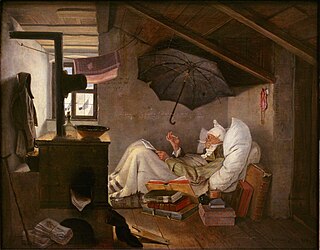
Carl Spitzweg was a German romantic painter, especially of genre subjects. He is considered to be one of the most important artists of the Biedermeier era.

Wilhelm Lehmbruck was a German sculptor. One of the most important of his generation, he was influenced by realism and expressionism.

Bushkill Falls is a series of eight privately owned waterfalls, the tallest of which cascades over 100 feet (30 m), located in Lehman Township, Pennsylvania in the Pocono Mountains. Water of the Little Bush Kill and Pond Run Creek descends the mountain, toward the Delaware River, forming Bushkill Falls, Bridal Veil Falls, Bridesmaid Falls, Laurel Glen Falls, Pennell Falls, and three additional, unnamed falls.

The Bookworm is an oil-on-canvas painting by the German painter and poet Carl Spitzweg. The picture was made c. 1850 and is typical of Spitzweg's humorous, anecdotal style and it is characteristic of Biedermeier art in general. The painting is representative of the introspective and conservative mood in Europe during the period between the end of the Napoleonic Wars and the revolutions of 1848, but at the same time pokes fun at those attitudes by embodying them in the fusty old scholar unconcerned with the affairs of the mundane world.

The Von der Heydt Museum is a museum in Wuppertal, Germany.

Franz Bronstert was a German engineer and painter.
Horst Gläsker is a German artist. His work is a symbiosis of music, dance, theatre, drawing, painting, sculpture, installation and architecture.

The Museum Georg Schäfer is a German art museum in Schweinfurt, Bavaria. Based on the private art collection of German industrialist Georg Schäfer (1896–1975), the museum primarily collects 19th-century paintings by artists from German-speaking countries.

Eduard Freiherr von der Heydt was a German and Swiss banker, art collector and patron.
Siegfried Wichmann was a German art historian and authority on Japonisme.
Rudolph J. Heinemann, also known as Rudolf J. Heinemann, was a German-born American art dealer and collector of Old Masters. He was an advisor to Baron Hans Heinrich Thyssen-Bornemisza, who established a museum in Lugano, Switzerland with his help. Heinemann and later, his wife Lore, donated works of art to the Metropolitan Museum of Art, the Frick Collection, the National Gallery of Art and the Morgan Library & Museum.

Gnome Watching Railway Train is an 1848 oil-on-wood painting by the German painter Carl Spitzweg.

The Poor Poet is the best known and most popular painting by German painter Carl Spitzweg. It was executed in 1839 and had three versions.

Carl Seibels was a German painter in the Biedermeier style.

Michael Knieriem is a German historian and author and was director of the Historisches Zentrum (Wuppertal) museum.
Jens Christian Jensen was a German art historian and curator.

Leo Bendel was a tobacco dealer and art collector.

Fox, also known as Blue and Black Fox or Blue Fox, is an oil on canvas painting by Franz Marc, from 1911. It is part of the collection of the Von der Heydt Museum in Wuppertal.

Woman with a Parrot at a Window, Woman at a Window or Woman with a Parrot is a 1666 oil-on-canvas painting by Caspar Netscher (1639–1684), which has been in the National Gallery of Art, in Washington, D.C., since 2016.

Adolf Erbslöh was a German Expressionist painter; one of the founders of the Neue Künstlervereinigung München.
















